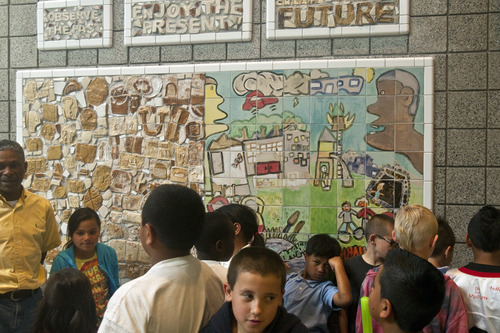This is an archived article that was published on sltrib.com in 2011, and information in the article may be outdated. It is provided only for personal research purposes and may not be reprinted.
Like many fourth-grade boys, Josh Teisina and Keli Sula dream of playing professional football when they grow up. They also hope to create a world where there is greater understanding between people who come from different cultures and backgrounds.
The boys painted the word "communication" into a new mural that depicts the past, present and future of children living in Salt Lake City's Glendale neighborhood.
Framing the "future" panel of the ceramic tile mosaic are two oversize boys, one white and one black, speaking to one another across a futuristic world with floating houses, robotic alligators and teleports.
"It's for, like, peace and to get along," Josh said.
On Tuesday, Riley Elementary School unveiled the hallway mural made of around 200 tiles. The art piece, Principal Bobbie Kirby said in an interview, showcases the diversity and potential of the school's 423 students. Eighty-five percent are minorities and 91 percent come from low-income families, according to school enrollment data.
Kirby encouraged community artist Roger Whiting, who led the collaborative project, to go beyond an initial idea of depicting solutions to historic problems in Glendale, such as poverty and crime.
"We need to stop defining the Glendale area in terms of gangs and violence," Kirby said in a written statement about the art. "Instead, we need to recognize the diversity, beauty, and resiliency of the people who live there."
About 50 students from Riley's after-school program and from Colors of Success, a program that builds relationships between at-risk kids and their high-achieving peers, designed the artwork. They were asked to think about their heritage, their ideas for improving the present and their vision of a perfect neighborhood.
"I think I saw some pride I hadn't seen before," said Lynn Green, coordinator of Colors of Success. "They gained a lot from this."
The "past" and "present" tiles were molded from brown clay. Thinking of their parents' histories, kids sculpted images ranging from a childhood home to a brick cell phone. The "present" tile encourages a college education — both the University of Utah and Brigham Young University are represented — and such activities as recycling and working out at the gym. (The workouts are for all the budding star athletes).
The "future" panel is the only piece done in color. Whiting asked each child to draw an image and then arranged those for the painted panel. Most are imaginative, including a flying car and a "six-dimensional" television set for those who have trouble seeing a regular one. Some are practical, such as household electricity and a prison for those who commit crimes.
"I improved my drawing [skills]," said fourth-grader Miesen Chanhom. Because he loves alligators and also would like to build robots when he grows up, he added the alligator robot to the scene.
The mural was funded with the help of a $2,500 grant from the Salt Lake Arts Council. Whiting, 33, met with students weekly from early January to late March and also hosted two family nights where parents created clay pots from the leftover materials. The pots also are on display at Riley.
"The beauty and the sincerity of the students' artwork taught me to better appreciate their heritage," Whiting said in the project statement. "Their power to change lives is apparent, because they already have changed my own for the better."



